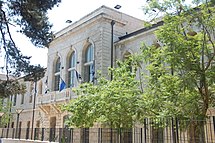Theodor Sandel (architect)
Theodor Sandel (born October 2, 1845 in Heilbronn , † July 1902 in Jerusalem ) was a German architect and surveyor who emigrated to Palestine after completing his training . He gained importance by surveying large parts of Palestine and became mayor of the temple colony in Jerusalem.
Life
Theodor Sandel was the son of the doctor Christian Gottlob David Sandel (1817–1879), who had come from Schwäbisch Hall to Heilbronn in 1844 and had been in contact with the temple society since the early 1850s . In 1858 the family moved to the Kirschenhardthof near Marbach am Neckar , a trial settlement built by the Templars. Sandel studied architecture at the Stuttgart Polytechnic from 1863 to 1866 , and also acquired knowledge of surveying technology . During the construction of the railway in the upper Danube valley, he worked as a government construction manager ( trainee lawyer ).
After his family had moved to Jaffa in 1869 , where his father worked at the hospital founded by Peter Martin Metzler , Sandel followed her in 1871. On behalf of Plato von Ustinows, he first mapped the city of Jaffa and the marshland of Wadi Miserara ( Arabic وادي المصرارة), today Ajalon ( נחל איילון) . A little later he came to Jerusalem , where he settled in the Templar settlement on the Rephaim plain . As their mayor, Kaiser Wilhelm II received him for an audience on October 28, 1898 in Jaffa as part of his Palestine trip. As an architect and cartographer , he was involved in the construction of the new temple settlements in Haifa , Jaffa and Sarona , as well as in the construction of the railway from Jaffa to Jerusalem , the mission station in Gaza , the hospice of the Catholic Palestine Mission in Jerusalem and several churches. The areas he first mapped include large parts of southern Palestine.
His first marriage was from 1874 to Klara Hardegg (1850-1885), a daughter of the businessman and co-founder of the temple society Georg David Hardegg . The marriage resulted in four sons and a daughter, including Benjamin Sandel (1877–1941), who was also an architect in the Holy Land (including building supervision of the Immanuel Church in Jaffa, construction of the Dormition Church , Jerusalem). After the death of his first wife, he married Lucie Sabine Bertsch (1851–1933) in Jerusalem in 1886. This second marriage produced another son.
Buildings
literature
- Helmut Schmolz, Hubert Weckbach: Significant Heilbronn (III). In: Schwaben und Franken, local history supplement of the Heilbronner Voice , 15th year 1969, No. 1 (from January 11, 1969).
Individual evidence
- ↑ a b Ejal Jakob Eisler: The German contribution to the rise of Jaffa 1850-1914. On the history of Palestine in the 19th century. Harrassowitz, Wiesbaden 1997, ISBN 3-447-03928-0 , p. 100. (= Treatises of the German Palestine Association , Volume 22.)
- ↑ Alex Carmel : The settlements of the Württemberg Templars in Palestine (1868-1918). 3rd edition, Kohlhammer, Stuttgart 2000, ISBN 3-17-016788-X , p. 38. (= Publications of the Commission for Historical Regional Studies in Baden-Württemberg, Series B, Research , Volume 77.)
- ↑ The map produced in the process appeared in the magazine of the German Palestine Association in 1880. Cf. Gottfried Schwarz, Jaffa and surroundings. In: Journal of the German Palestine Association. Volume 3, pp. 44-51.
- ↑ Ejal Jakob Eisler: The German contribution to the rise of Jaffa 1850-1914. On the history of Palestine in the 19th century. P. 116.
- ↑ Ejal Jakob Eisler: The German contribution to the rise of Jaffa 1850-1914. On the history of Palestine in the 19th century. P. 134.
- ↑ a b August Strobel : Your walls always stand before me. Buildings and monuments of German settlement and research history in the Holy Land. Brunnen, Gießen 1998, ISBN 3-7655-9807-0 , p. 88 ff. ( Biblical archeology and contemporary history. Volume 7).
| personal data | |
|---|---|
| SURNAME | Sandel, Theodor |
| BRIEF DESCRIPTION | German architect and surveyor in Palestine |
| DATE OF BIRTH | October 2, 1845 |
| PLACE OF BIRTH | Heilbronn |
| DATE OF DEATH | July 1902 |
| Place of death | Jerusalem |





